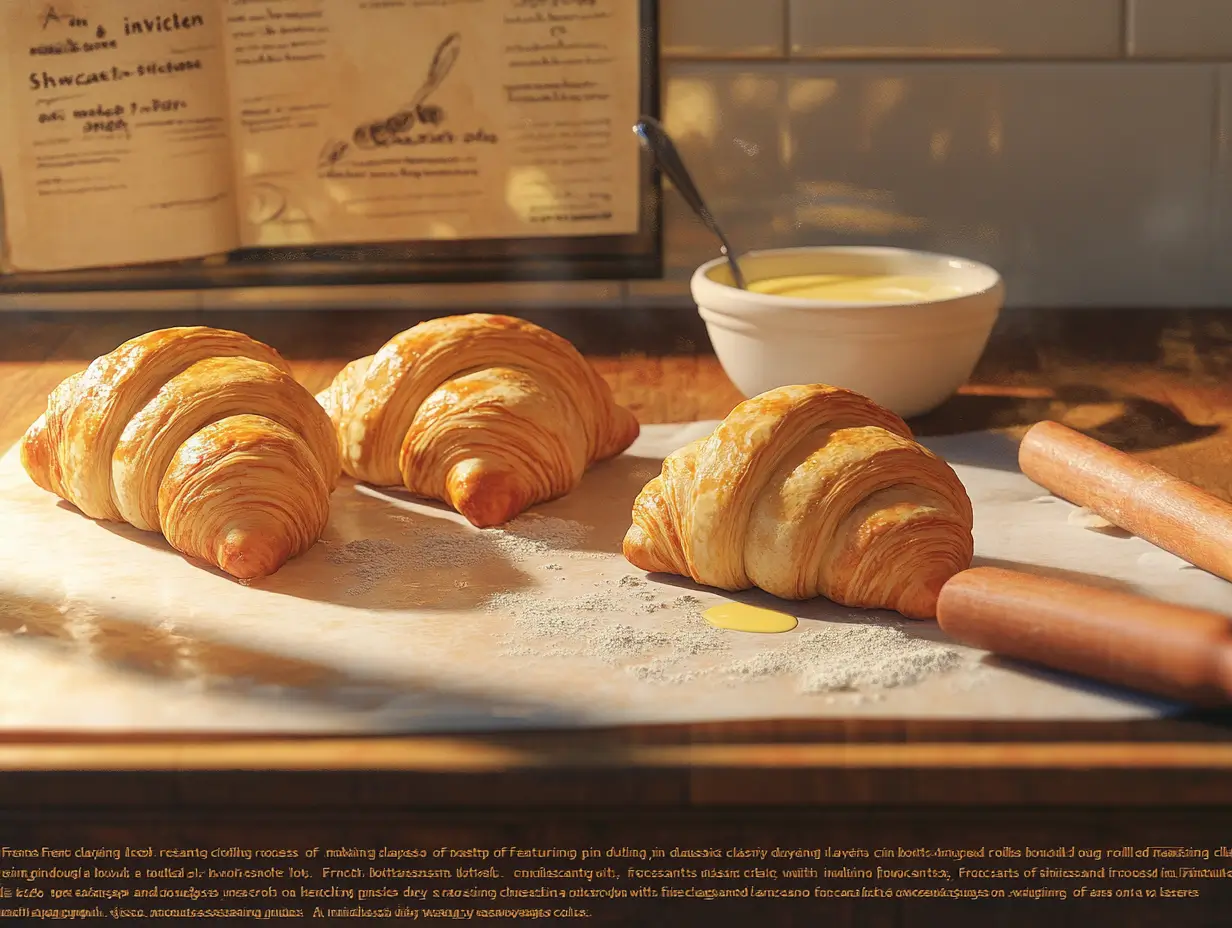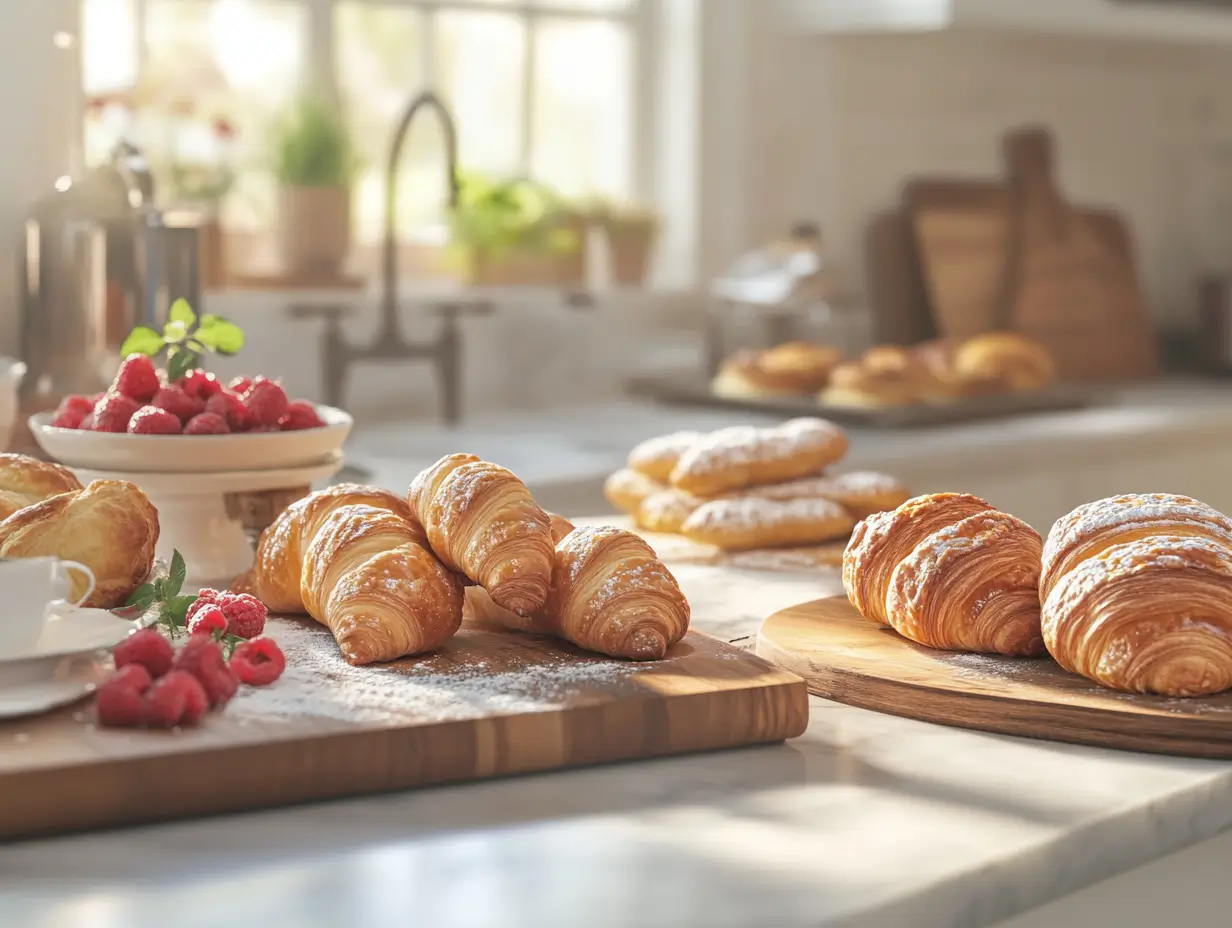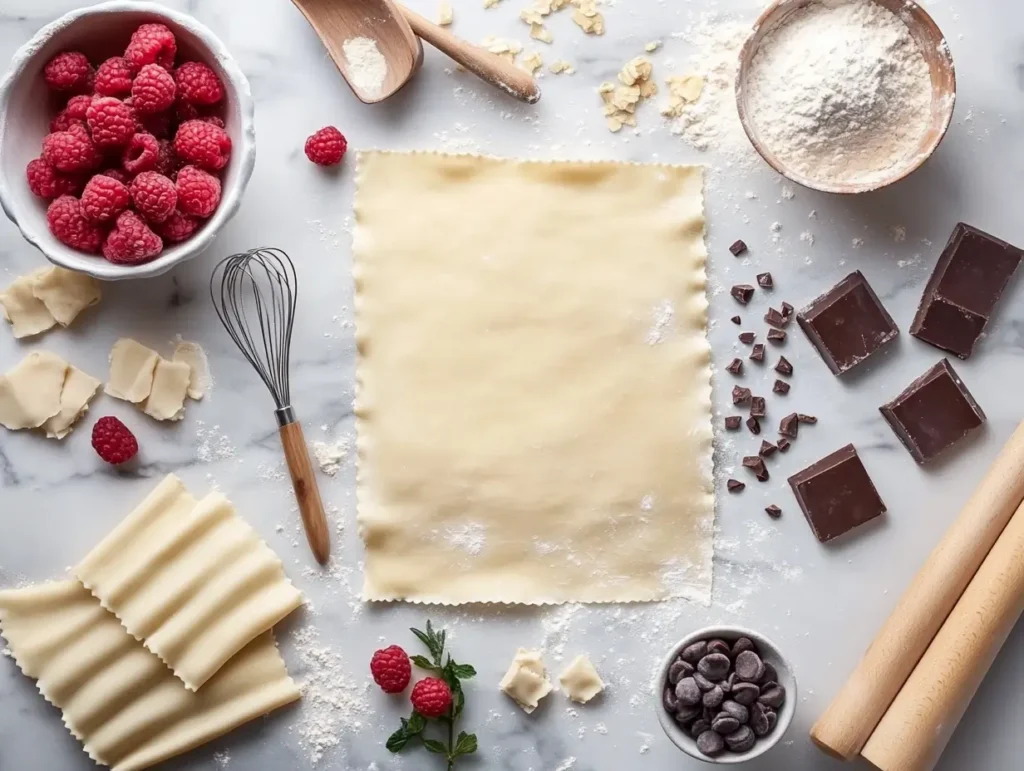There’s magic in pulling warm pastries from your oven. The smell of butter and dough makes mornings special. I used to think only pros could make great pastries. But now, with my breakfast pastry recipe, I make french pastries at home.
Imagine making flaky croissants, soft brioche, and delicate scones yourself. You don’t need to be a pro to start. This guide will teach you how to make bakery-quality treats at home.
These breakfast pastry recipes are perfect for beginners or those who want to improve their baking skills. You’ll learn how to make amazing breakfast pastry step by step. With these recipes, you’ll discover ways to save money, customize flavors to your liking, and create pastries that everyone will enjoy. Plus, you’ll love sharing your homemade treats from these breakfast pastry recipes with family and friends.
Are you ready for a tasty journey? It will change your mornings and impress your friends. Let’s start making homemade pastry magic!
Essential Equipment and Ingredients for Homemade Pastries
Making tasty baked goods starts with the right tools and ingredients. Whether you’re new or experienced, knowing the basics of pastry dough can change your baking at home.
Must-Have Baking Tools
Having the right tools is key for perfect pastries. Here are the must-haves for every home baker:
- High-quality rolling pin for smooth pastry dough
- Pastry bench scraper for precise cutting
- Silicone baking mats
- Digital kitchen scale for accurate measurements
- Pastry brush for egg washes and glazes
Quality Ingredients for Perfect Results
Exceptional baked goods come from top-notch ingredients. Invest in:
- European-style butter with higher fat content
- Fresh, large eggs
- High-quality vanilla extract
- Organic unbleached flour
“Great pastries begin with great ingredients” – Professional Pastry Chef
Understanding Different Types of Flour
Choosing the right flour changes your pastry’s texture and taste. Each flour has its own use in baking:
| Flour Type | Best Used For | Protein Content |
|---|---|---|
| All-Purpose Flour | General baking | 10-12% |
| Bread Flour | Chewy pastries | 12-14% |
| Pastry Flour | Tender baked goods | 8-9% |
Knowing these basics helps you make pro-quality pastries at home.
Classic French Croissant Step-by-Step Guide
Learning to make french pastries starts with mastering the croissant recipe. These flaky, buttery treats need patience, precision, and practice. They’re known for their unique texture.

- High-protein bread flour
- Active dry yeast
- Granulated sugar
- Salt
- Whole milk
- Unsalted European-style butter
The secret to making authentic french pastries is the lamination process. This involves folding and chilling dough and butter to create flaky layers.
“The secret to a perfect croissant is patience and cold butter” – Professional Pastry Chef
Your croissant recipe will have several important steps:
- Prepare the yeasted dough
- Create a butter block
- Laminate the dough through multiple turns
- Shape the classic crescent
- Proof and bake to golden perfection
| Stage | Time Required | Key Technique |
|---|---|---|
| Dough Preparation | 30 minutes | Mixing and kneading |
| Butter Lamination | 2-3 hours | Folding and chilling |
| Proofing | 1-2 hours | Room temperature rise |
| Baking | 15-20 minutes | Golden brown finish |
Pro tip: Use cold ingredients and work fast to keep the butter good. Your hard work will pay off with delicious, flaky croissants.
Related Post
Quick and Easy Breakfast Pastry Recipes
Busy mornings don’t mean you have to skip a delicious breakfast. You can make tasty pastries quickly. A breakfast pastry recipe doesn’t have to be hard or take a lot of time.

Time-Saving Morning Shortcuts
Make your morning easier with these simple morning pastries recipe tips. Use pre-made puff pastry to save time and simplify the process. Keep frozen pastry sheets in your freezer for quick and easy morning pastries that are perfect for busy mornings.
- Thaw pastry sheets overnight in the refrigerator
- Prepare fillings the night before
- Use store-bought pie dough for instant convenience
Make-Ahead Pastry Options
Prepare your breakfast pastry recipe ahead of time. Many pastries can be made and refrigerated overnight. Then, bake them fresh in the morning.
- Assemble pastries the evening before
- Cover and refrigerate
- Bake directly from the refrigerator
Simple Filling Ideas
Make your morning pastries special with creative fillings. Choose from sweet or savory options to turn your breakfast treat into a gourmet delight.
“The secret to an amazing pastry is a delightful filling that surprises and satisfies.” – Pastry Chef Emma Richardson
Sweet filling suggestions:
- Cream cheese and berry compote
- Nutella and sliced almonds
- Apple cinnamon roll with caramel drizzle
Savory filling options:
- Scrambled eggs and cheese
- Spinach and feta
- Ham and Swiss cheese
Mastering the Perfect Breakfast Pastry Dough

Making perfect pastry dough is like magic. It turns simple things into something amazing. You might want a flaky pastry or a soft crust. Knowing the science behind it is key to success.
The secret to a great breakfast pastry recipe lies in the technique and keeping everything cold. Ensure your butter stays cold, and work quickly to prevent it from melting. This is the key to creating the flaky layers that make breakfast pastries irresistibly delicious.
“Pastry making is about patience and precision – treat your dough like a delicate science experiment.”
- Use ice-cold water when mixing pastry dough
- Handle the dough minimally to prevent gluten development
- Rest your dough in the refrigerator for at least 30 minutes
- Use a light touch when rolling out pastry dough
Different pastries need different ways to make them. Puff pastry needs careful layers of butter and dough. Shortcrust pastry needs gentle mixing to stay soft. Knowing these tricks will make your baking amazing.
Getting better at pastry dough takes practice. Don’t worry if it’s not perfect at first. Every try teaches you something new about working with this delicate dough.
Sweet and Savory Brioche Variations
Brioche bread makes your breakfast special. It’s rich and buttery, perfect for sweet and savory treats. These will make your taste buds happy.
Brioche is more than bread. It’s a canvas for your creativity. Its soft texture and rich flavor are ideal for many breakfast recipes.
Traditional Sweet Brioche Delights
Classic sweet brioche offers many tasty options. Here are some to try:
- Chocolate-filled brioche rolls
- Cinnamon roll sugar brioche twists
- Nutella-stuffed brioche knots
- Almond cream brioche
Innovative Savory Breakfast Brioche
Make your brioche into a hearty breakfast with these ideas:
- Spinach and feta brioche rolls
- Bacon and cheese brioche pockets
- Herb-infused brioche with scrambled eggs
- Prosciutto and mozzarella brioche
Storage and Reheating Tips
| Storage Method | Duration | Recommended Reheating |
|---|---|---|
| Room Temperature | 2-3 days | Warm in oven at 300°F for 5-7 minutes |
| Refrigerated | 5-7 days | Toast lightly or warm in microwave for 15-20 seconds |
| Frozen | Up to 1 month | Thaw at room temperature, then warm in oven |
Pro tip: Always wrap brioche bread tightly to maintain its moisture and prevent it from drying out.
“A great brioche is like a culinary work of art—simple yet sophisticated.” – Professional Baker
Related Post
Flaky Scones and Muffin Basics
Learning about scones and muffins can make your mornings special, especially when following a great breakfast pastry recipe. The key is understanding how to mix the ingredients and bake them properly. This ensures your breakfast pastries turn out perfect every time.
For scones, cold butter is very important. Cut it into small pieces and mix it into the flour fast. This keeps the butter cold. You want your scones to be flaky and light.
- Use high-quality pastry flour for the best texture
- Keep ingredients cold during preparation
- Minimal mixing prevents tough scones
- Experiment with sweet and savory mix-ins
When baking muffins, don’t overmix the batter. This makes muffins dense. Mix wet and dry ingredients gently until just combined. This makes your muffins soft and delicious.
“Baking is love made edible” – Unknown Pastry Chef
Try these flavors to make your scones and muffins even better:
- Blueberry lemon scones
- Chocolate chip banana muffins
- Savory herb and cheese scones
- Apple cinnamon roll streusel muffins
With practice and patience, you can make amazing pastries at home.
Troubleshooting Common Pastry Problems
Making the perfect flaky pastry can be challenging, even for experts. However, following a reliable breakfast pastry recipe and learning how to fix common pastry dough problems will help you achieve great results every time.
Identifying and Solving Dough Challenges
Many issues can happen with pastry dough. Here are some fixes:
- Sticky dough: Chill your pastry dough for 30 minutes before handling
- Dry, crumbly texture: Add ice water one teaspoon at a time
- Tough pastry: Minimize handling and avoid overworking the dough
Mastering Temperature Control
Temperature is key for perfect flaky pastry. Here are some tips:
| Temperature Issue | Solution |
|---|---|
| Warm Butter | Refrigerate dough between folding stages |
| Uneven Baking | Use an oven thermometer to check accuracy |
| Cold Ingredients | Keep butter and water chilled before mixing |
Resolving Texture and Rising Issues
Getting the right pastry texture needs focus. Proper technique and ingredient preparation help avoid common issues:
- Use cold ingredients to keep dough structure
- Rest dough between rolling and baking
- Avoid overworking to prevent gluten development
“Perfect pastry is about patience and precision” – Professional Baker’s Wisdom
With these tips, you can make delicious, flaky pastries. They will wow your family and friends.
Professional Tips for Bakery-Quality Results
To make your home-baked goods as good as a bakery’s, follow a well-crafted breakfast pastry recipe and focus on precision and skill. Professional pastry chefs agree that success comes from mastering small techniques. These techniques can transform your breakfast pastries from good to truly great.
“Perfection in pastry is about passion and precise technique,” says renowned pastry chef Michel Laurent.
To get bakery-quality results, pay close attention to important details:
- Use high-quality European-style butter for richer flavor
- Invest in professional-grade digital kitchen scales
- Control kitchen temperature during pastry preparation
- Practice consistent folding techniques for flaky layers
Keeping your ingredients and workspace cool is essential when following a breakfast pastry recipe, especially for French pastries. This is crucial when working with delicate doughs. Chilled butter is the secret to achieving those crisp, flaky layers that make professional breakfast pastries truly stand out.nd out.
Professional bakers also suggest these tips:
- Chill dough between folding stages
- Use parchment paper for consistent baking
- Egg wash for perfect golden-brown finish
- Rest pastries before baking to develop flavor
By using these professional tips, you can make your homemade pastries look and taste like they came from a bakery. They will impress and delight everyone.
Related Post
Breakfast Pastry recipes: Conclusion
Making tasty breakfast pastries at home is an exciting experience. It all begins with learning basic skills and improving your baking techniques. Every breakfast pastry recipe you try brings you one step closer to becoming a pro in the kitchen.
Quick breakfast ideas like scones and croissants can change your morning. Try new techniques and ingredients to find your style. Remember, every great baker began by learning and trying new things.
The fun part of making pastries is enjoying the process. Don’t worry about mistakes or trying new flavors. Your kitchen is a place to be creative.
Keep trying, stay curious, and share your pastries with others. Your baking adventure is just starting. Enjoy every moment of making delicious pastries.

